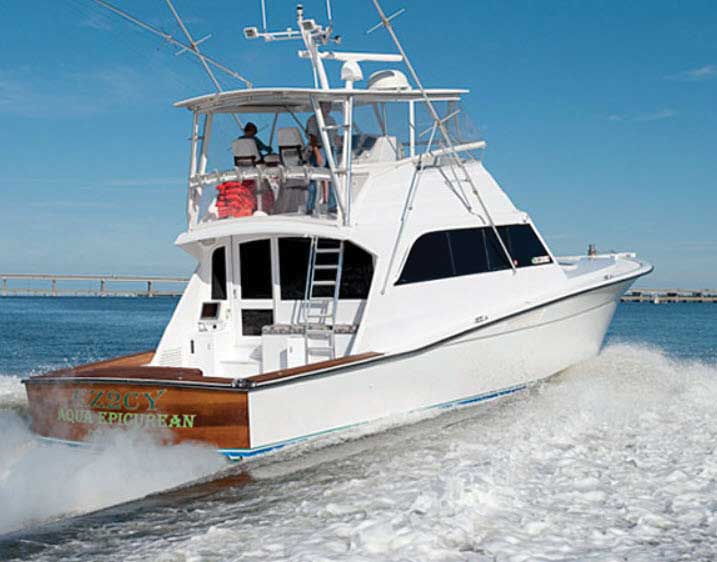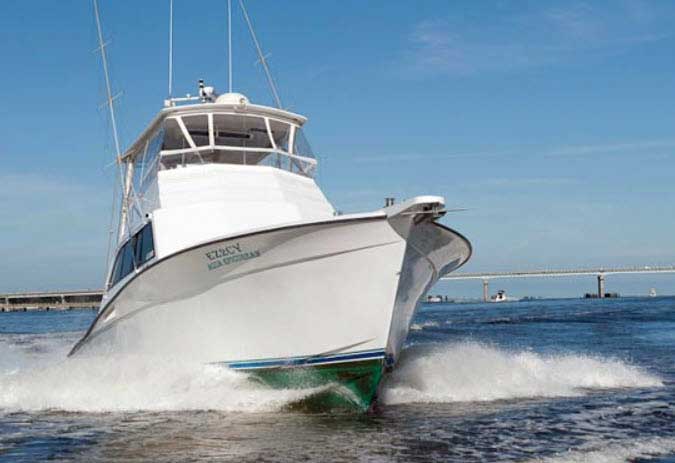Jeff Smith extended his 1989 54-foot Egg Harbor Sportfisherman into the EZ2CY Aqua Epicurean, a 57-foot sportfisherman/cruiser. He’s an expert on yacht modifications and an experienced boatsman from a long line of boat ownership.

Successfully lengthening a yacht is a daunting task. Measurements must be taken, the yacht cockpit interior and exterior must be prepared, and a mold to build the new transom part must be made (fiberglass boat parts are made in this case in a plywood mold and then made of fiberglass cloth and liquid resin laid up in that mold). They also must make the interior of the mold smooth, and then pick the resin and fiberglass cloth that will make a strong, structural new transom that adds three feet to the boat’s cockpit.
Fiberglass is laid up in layers, with each layer hardening before the next one is laid in on top of the prior one. This is done several times in the mold to build up to a thick hull and transom part.
Releasing the part from the mold is sometimes tricky. The new part is then bolted and fiberglassed to the boat. Minor fairing and final painting or colored gelcoat are done next.
Jeff is heavily involved with the Kent Island Yacht Club, where he keeps his 57-foot boat. It is a great club with lots of amenities for the whole family (like a pool, and even a room for dancing). As a social club they have many events, too numerous to mention, and are very active socially beyond just boat owners.

Jeff also is involved with EZ2CY enclosures, which they say are the most durable and reliable enclosures for yachts in the marine industry. The enclosures are fabricated from impact-modified acrylic specifically for use in harsh marine environments. EZ2CY enclosures are compatible with any vessel type and are typically preferred over soft vinyl enclosures. The components are carefully selected and continually evaluated to maintain their superior quality standards.
Egg Harbor boasts one of the oldest names in American boatbuilding history. In 1946, John Leek and Russel Post established Egg Harbor Yachts in New Jersey to build 14-foot rowboats. After two other partners joined, Ted Haggas (well known for his Jersey Sea Skiffs) designed a 28-foot skiff that the partners launched under the name of Egg Harbor Boat Company.
Leek and Post parted ways within a few years. But by 1966, the founders joined forces again, combining the Pacemaker and Egg Harbor brands. Like many boat builders, the brand suffered through some hard years in the 1980s and 1990s, in large part due to high interest rates and the ill-fated luxury tax.
That ended it. The New Jersey coast proved to be an ideal testing ground for those early models. Post made it a point to personally run each boat in order to assure its seaworthiness in all sea conditions.

In the 60s George Stadel was an early designer of Egg Harbor boats. His son Bill remembers his father designing the 37 in four long days, modifying the 36 to make it a bit finer in the bow and removing the tumblehome back aft, thereby adding beam at the sheerline. The 37 is widely recognized as “the boat that created the Egg Harbor brand.”
Egg Harbor started building 50 of the 37s per year and increased production to 100 per year. The final count was somewhere between 800 and 850 hulls over a period of about 10 years.
Egg Harbor Boat Company grew in the 60s, and the 37 transitioned from traditional wood to fiberglass in the early 70s. Lengths ranged from 35 to 60 feet for both Open and Convertible Yachts, built for fishermen to provide a smooth ride, comfortable amenities, and serious fishing.
Unfortunately, Egg Harbor Boat Company found itself in and out of financial difficulties due to production issues during the 90s and eventually folded.
Nonetheless, Egg Harbor boats are highly sought after and much loved by their owners. EZ2CY Aqua Epicurean is lined up to appear at the June 16-18 Antique and Classic Boat Festival in St Michaels, MD.
By Chris “Seabuddy” Brown